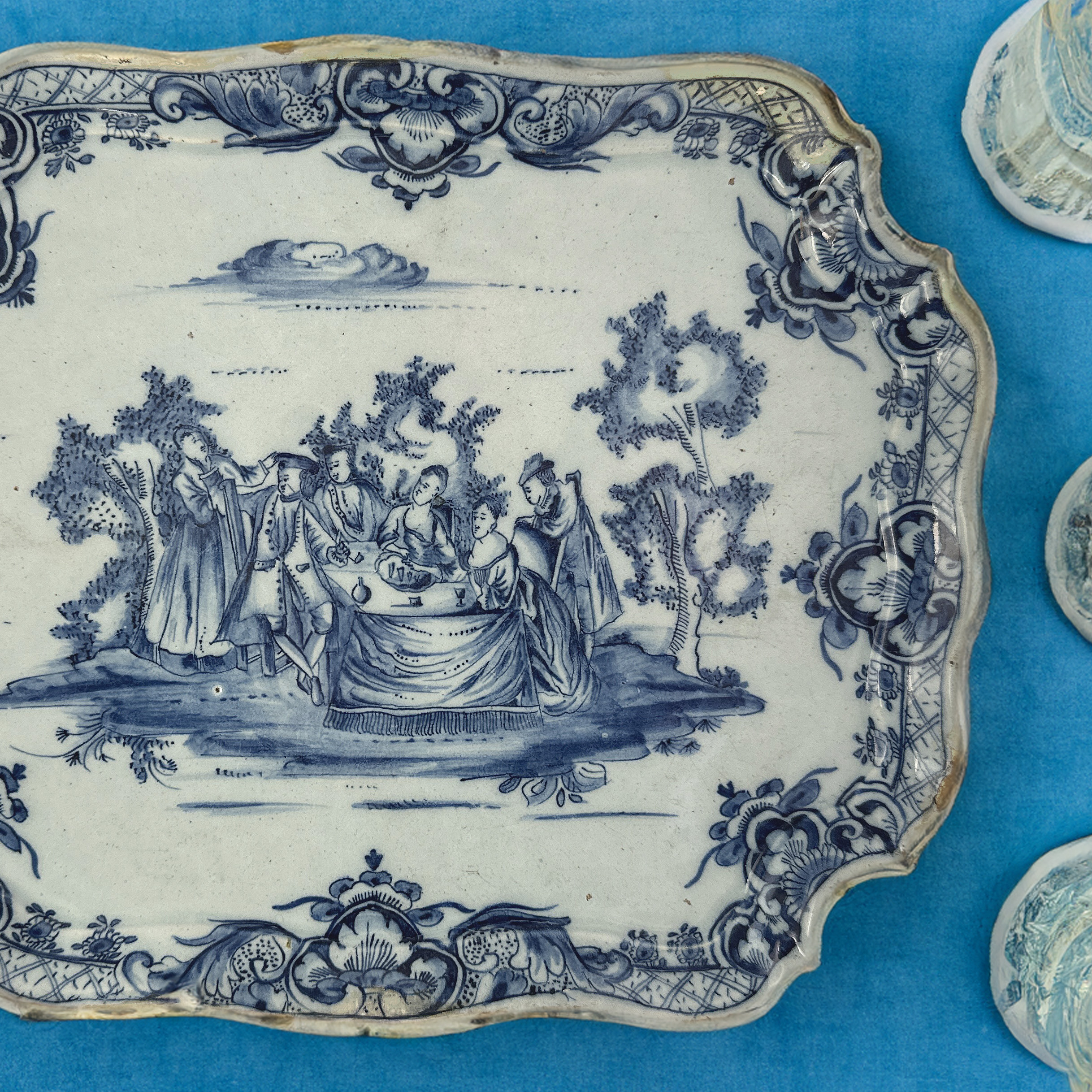
Delft Trays
The emergence of tea and coffee culture in the Dutch Republic led to a notable expansion in the diversity of household goods. The increasing popularity of these beverages presented lucrative opportunities for manufacturers of related objects.(1)
While beverages like beer, spirits, water, or wine merely required a bottle or jug and glasses for consumption, coffee- and tea-drinking, especially in social gatherings, demanded an assortment of objects. Besides the indispensable teapot or coffeepot and cups, a wealthy, fashionable woman could use a variety of items such as bowls, dishes, and various containers. Serving accessories, being prominent status symbols, were equally as crucial as the beverages themselves.(2)
Delft potters entered the burgeoning market for coffee and tea utensils on a smaller scale than their Chinese counterparts. They presented diversified offerings, such as the serving tray, which has not yet been extensively researched. The tray itself wasn’t a novel invention; it had long been utilized to carry objects related to eating and drinking. However, evolving dining and drinking habits, albeit modestly, gradually elevated its significance, prompting the emergence of a wider array of models and materials. This article aims to explore the emergence of Delft faience serving trays, their purpose, production origins, and decorative motifs.
Genre paintings and Dutch dollhouses reveal the use of trays in affluent households as early as the seventeenth century. Dollhouses became a popular and very costly pastime among wealthy ladies and they give a realistic idea of the inventory of the high society.
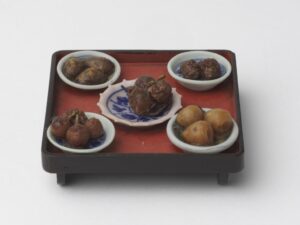
of Petronella de la Court
in the collection of Centraal Museum, Utrecht
inv. nr. 5000/188-a
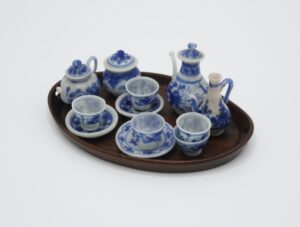
A dollhouse commissioned by Petronella de la Court (1624-1707), spouse of a wealthy Amsterdam silk merchant, stands as a significant testament to the lifestyle of the elite in the Dutch Republic during the latter part of the seventeenth century. Among the 1500 parts of her miniature house are several oval and rectangular trays: two in the parlor, one with a beer jug and glasses and another tray with three rummer glasses.(3) In the nursery, a wooden oval tray holds one of the earliest examples of a homogenous tea set, complete with a milk jug and sugar bowl (fig. 2).(4) In the maternity room, a rectangular so-called ‘pouring tray’, which is characterized by a raised edge, holds a porcelain ewer with canary wine, served with porcelain cups and saucers. Such a tray was specifically used to prevent fluids coming in contact with the costly wooden or lacquered tables. A footed square tray with small porcelain dishes of sweetmeats is also present in the same room (fig. 21).(5)
While Oriental lacquer, wooden or silver serving trays were prevalent before 1700 (6), an early Delft tray marked with the factory mark SVE for Samuel van Eenhoorn, owner of ‘De Grieksche A’ (the Greek A) factory from 1678 to 1685, made around 1680 proves that Delft trays did exist before that date (fig. 3). This fine example, decorated with Chinoiserie scenes, can be considered one of the first known Delft faience trays. While its exact purpose remains unclear, this tray bears a striking resemblance in shape to the square wooden tray observed in the maternity room of Petronella de la Court’s dollhouse, suggesting it may have also functioned as a sweetmeat tray. The presence of a marking indicates that, in any case, the Griekse A (the Greek A) was involved in the production of trays during the last quarter of the seventeenth century.
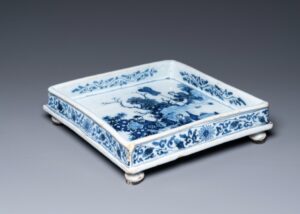
The renowned Dutch physician Cornelius Bontekoe (1647-1685), hailing from Alkmaar and later residing in Berlin, earned the moniker “tea doctor” for his important role in introducing tea to the Low Countries. He stood as a significant figure advocating for the consumption of tea, coffee, chocolate, and tobacco as means to maintain good health. Bontekoe’s principal treatise on tea, ‘Tractaat van het excellentste kruyd Thee‘ (Treatise of the most excellent herb Tea), extolling its beneficial effects on health, was initially published in 1678. Bontekoe recommended Delft teapots in addition to pewter or red stone ware ones. Perhaps the treatise of Bontekoe not only played an important role in the popularity of tea, but it might have inspired the development of specialized Delft faience utensils as well. However, no other Delft trays before the 1720s emerged in this research.
Following this period, the modest presence of Delft trays is evidenced by various examples, including an intriguing piece with Chinoiserie decoration marked for Cornelis Koppens, the owner of the ‘De Metaale Pot’ (The Metal Pot) factory from 1724 to 1756.(7) Derived from a silver model, the tray is rectangular with four lobbed corners and raised on four feet. The lobes probably held cup-and-saucers. The production of this early tray further underscores the innovative contributions made by ‘De Metaale Pot’ to the Delft industry.
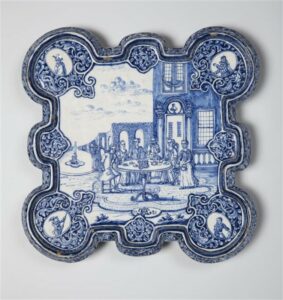
As tea became more affordable due to increased imports, its popularity surged, likely fueling innovations. Consequently, Delft pottery continued to evolve and develop throughout the eighteenth century. A great example is this important small scalloped tray from 1731. It not only provides evidence of the existence of Delft trays during that time (fig. 4), but the depiction also reflects its purpose, as the tray itself is repeated in the decoration, holding sweetmeat on a tea table surrounded by an elegant company drinking tea. A similar model with a different decoration is in the collection of the Rijksmuseum Amsterdam. Depicted with two tables in the garden, one with conversing gentlemen, with a round tray holding two jugs. Around the other table ladies gather for tea served on a round tray. Both examples are marked for J. Aalmis owner of the Rotterdam based tile and faience factory ‘De Bloempot’ (the Flowerpot) and an unattributed ‘CB’ and star.
There is a long-standing debate surrounding this signature; on the one hand suggesting a collaboration with the Delft faience factory ‘De Witte Ster’ (the White Star) factory, while on the other hand, it is attributed to Cornelis Bokhoven, an employee of ‘De Bloempot’ at that time. (8) Although this example does not conclude whether ‘De Witte Ster’ produced trays, another tray in the Rijksmuseum mentioned earlier in footnote 7 is attributed to this factory. This suggests that the factory was among the first to produce trays.
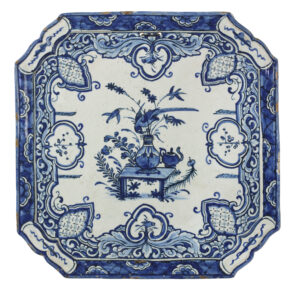
Another interesting example is a 1737 dated plaque in the Aronson collection with four abrasions at the reverse. The abrasions indicate that it was originally intended as a tablet (fig 5).(9) The presence of suspension holes on this plaque is not unusual, as trays and tablets have served as wall decorations in later periods.(10) The holes on this plaque are original, suggesting that such perforations may have been intentionally incorporated into trays beforehand for hanging purposes, similar to various other utensils. However, this hypothesis requires further research for validation.
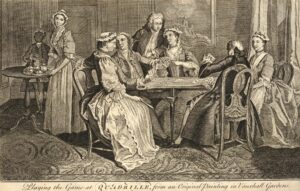
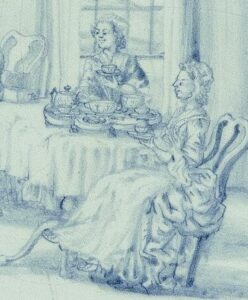
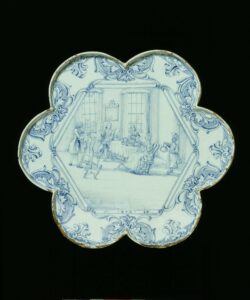
Although not from Delft, but very much related and therefore interesting to include in this research, is another compelling example that provides insight into its purpose (fig. 6). This large English Delft lobbed tray dated 1743, is decorated with a similar tray, vividly illustrating its function as a serving vessel for tea. The cups, a teapot, and a sugar bowl are nestled within the arches. Positioned at the center is the ‘spoelkom’ (slop-basin). Additionally, a servant is depicted holding a kettle and a small tray of sweetmeats. As in the previous scalloped trays dated 1731, this design is also influenced by silver examples that were popular in the first half of the eighteenth century, shown on a print after Francis Hayman (fig. 7) and by a silver example in the Rijksmuseum.(11)
The continued use of trays as carriers for glasses and bottles in the mid-eighteenth century is illustrated by a recent acquisition; a rectangular Delft serving tray with a curved border based on a low standing ring (fig. 8). This interesting piece portrays a group of men and women gathered around a table in the garden, enjoying drinks and smoking pipes. At their table a comparable serving tray is depicted, holding glasses of various sizes. This renders the object a historical document in its own right, offering glimpses into daily life in past times.
A rare painted wooden cabinet, signed by the Dutch artist Pieter de la Croix (1709-1782) and dated 1769, depicts a captivating scene featuring two distinct trays. One of these trays, likely ceramic and possibly Delft, adorned with fruit, offers insight into the different contents served during that era.(12) Additionally, the cabinet depicts a silver tray bearing rummer glasses.
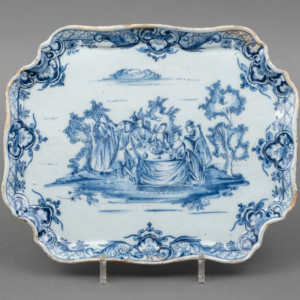
Smaller, footed square trays have been part of tête-a-tête sets, used for tea for two persons, that could hold a teapot, two cups and saucers, a milk jug and sugar pot.(14) At times, the teapot would be placed on a similar small size stand resembling a tile with feet. These teapot stands functioned as insulation, shielding the table or tray surface from the potentially damaging heat emanating from the teapot.(15) The two royal portrait trays on feet, depicting Royal Princess of Orange Anna von Brunswick Lunenburg (1709-1759) and her husband Royal Prince of Orange Willem Carel Hendrik Friso (1711-1751) could have held both functions (fig. 9a and b).
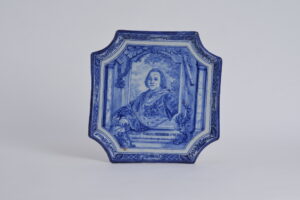
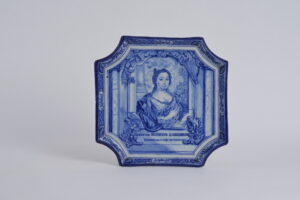
From the latter part of the eighteenth century onward, there were new oval and rectangular models, some with handles and some without, intended to carry a complete tea set. Their style mirrored the popular forms of Louis XVI-era design.(16) Due to the limited number of surviving trays, it remains unclear whether the models and decorative themes that appear, such as biblical scenes, landscapes, and professions are representative.(17)
The limited surviving examples of Delft faience trays are likely due to their fragility. Despite not coming into direct contact with boiling water, unless when it was spilled during pouring hot fluids, Delft trays shared the disadvantage with other Delft tea utilities as porous and unable to withstand heat. Earthenware conducts heat more readily than porcelain, rendering it prone to cracking when exposed to significant temperature fluctuations. Moreover, if the glaze becomes cracked, the underlying material loses its seal, leading to deterioration upon contact with water and therefore less practical than their counterparts made of silver, wood, lacquer, and even porcelain.
Summary
Drawing insights from genre paintings depicting trays, as well as from inventories of dollhouses and the limited number of surviving trays, it becomes evident that Delft trays were not deemed essential household items. Some rare examples indicate their use as serving items for food and drink, while others functioned as coasters for tea pots or kettles. The presence of suspension holes further seem to imply a decorative purpose.
Marked examples reveal that ‘De Grieksche A’ (The Greek A) factory, ‘De Metaale Pot’ (The Metal Pot) factory, and possibly ‘De Witte Ster’ (The White Star) factory were involved in tray production. The prominence of the first two factories is unsurprising, as they were regarded as the most innovative workshops for Delft faience.
Due to the scarcity of trays, the various themes depicted on them cannot yet be fully explained. Serving trays were luxury items that never gained widespread popularity, likely due to their fragility, which must have contributed to their limited production in Delft.
Notes
1 https://www.aronson.com/blue-and-white-teapots/
2 British Art Journal, Volume X, No. 1, Ching-Jung Chen, ‘Tea Parties in early Georgian Conversation pieces’, 2009, p. 30
3 Pijzel-Dommisse, 2011, p 165. Several paintings dating from the eighteenth century illustrate the longstanding glass serving function of these trays as being illustrated in: Fock Red, 2001, p. 235 and p. 260
4 https://www.centraalmuseum.nl/nl/ontdek/verhalen/poppenhuis
5 Idem
6 Roth, 1961 and Ter Molen, 1978, p. 62
7 That trays start to emerge by this date is also evidenced by two Chinoiserie trays in the collection of the Rijksmuseum Amsterdam, dated in this period. A round one: http://hdl.handle.net/10934/RM0001.COLLECT.16065 a scalloped one http://hdl.handle.net/10934/RM0001.COLLECT.14393 . The Cornelis Koppens one, sold at Christies: https://www.christies.com/en/lot/lot-5480525 7
8 De Jager and Schadee, 2009, pp.161-162
9 A similar presence of round unglazed circles on the reverse of a tray/plaque can be found at lot number 131 in Bonhams London Fine European Ceramics sale of December 2011: https://www.bonhams.com/auction/19110/lot/131/a-dutch-delft-lobed-tray-early-18th-century/
10 Ter Molen, 1978, p. 62
11 Silver lobbed salver, Jan van Cloon, 1729 in the collection of the Rijksmuseum Amsterdam: http://hdl.handle.net/10934/RM0001.COLLECT.296587
12 Fock Red, 2001, p. 235 and p. 260
13 A purpose also referenced in footnote three.
14 Ter Molen, 1978, p. 62
15 Roth, 1961, pp. 61-91: https://www.gutenberg.org/files/46775/46775-h/46775-h.htm
16 From the 1780s this tray in the collection of the Rijksmuseum Amsterdam: http://hdl.handle.net/10934/RM0001.COLLECT.236579
17 Examples of these models and decors can be found in the collection of the Rijksmuseum: http://hdl.handle.net/10934/RM0001.COLLECT.236579, and as lot 605 in live auction 1327, New York, January 2004
Literature
Chen, Ching-Jung, in: British art Journal, Volume X, No. 1, ‘Tea Parties in early Georgian Conversation pieces’, 2009
Fock, Willemijn, Red, ‘Het Nederlandse Interieur in beeld 1600-1900′, Zwolle, 2001
Jager, Ingrid de and Nora Schadee, ‘itegels uit Rotterdam. 1609-1866’, Rotterdam, 2009
Molen, J.R. ter, ‘Thema Thee. De Geschiedenis van de thee en het theegebruik in Nederland’, Rotterdam, 1978
Pijzel-Dommisse, Jet, ‘Het Hollands Pronk Poppenhuis’,Zwolle/Amsterdam, 2011, p 165. Several paintings dating from the eighteenth century illustrate the longstanding glass serving function of these trays as being illustrated in: C. Willemijn Fock Red, ‘Het Nederlandse Interieur in beeld 1600-1900′, Zwolle, 2001
Roth, Rodris, ‘Tea Drinking in 18th-Century America: Its Etiquette and Equipage’, United States National Museum Bulletin 225, Contributions from the Museum of History and Technology Paper 14, pages 61-91, Smithsonian Institution, Washington, DC, 1961, Online release Date: September 13, 2014: https://www.gutenberg.org/files/46775/46775-h/46775-h.htm



